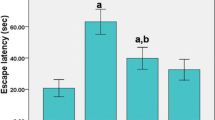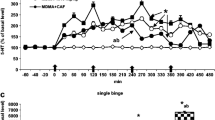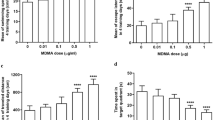Abstract
There is abundant evidence showing that repeated use of MDMA (3, 4-Methylenedioxymethamphetamine, ecstasy) has been associated with depression, anxiety and deficits in learning and memory, suggesting detrimental effects on hippocampus. Adenosine is an endogenous purine nucleoside that has a neuromodulatory role in the central nervous system. In the present study, we investigated the role of A2a adenosine receptors agonist (CGS) and antagonist (SCH) on the body temperature, learning deficits, and hippocampal cell death induced by MDMA administration. In this study, 63 adult, male, Sprague - Dawley rats were subjected to MDMA (10 and 20 mg/kg) followed by intraperitoneal CGS (0.03 mg/kg) or SCH (0.03 mg/kg) injection. The animals were tested for spatial learning in the Morris water maze (MWM) task performance, accompanied by a recording of body temperature, electron microscopy and stereological study. Our results showed that MDMA treatment increased body temperature significantly, and impaired the ability of rats to locate the hidden platform(P < 0.05). The number of hippocampal dark neurons also increased especially in CA1. These impairments were aggravated by co-administration of A2a antagonist (SCH) with MDMA. Furthermore, the administration of the A2a receptor agonist (CGS) provided partial protection against MWM deficits and hippocampal cell death(P < 0.05). This study provides for the first time evidence that, in contrast to A2a antagonist (SCH) effects, co-administration of A2a agonist (CGS) with MDMA can protect against MDMA hippocampal neurotoxic effects; providing a potential value in the prevention of learning deficits observed in MDMA users. However, the exact mechanism of these interactions requires further studies.







Similar content being viewed by others
References
Abekawa T, Ohmori T, Koyama T (1994) Effects of repeated administration of a high dose of methamphetamine on dopamine and glutamate release in rat striatum and nucleus accumbens. Brain Res 643:276–281
Able JA, Gudelsky GA, Vorhees CV et al (2006) 3, 4- methylenedioxymethamphetamine in adult rats produces deficits in path integration and spatial reference memory. Biol Psychiatry 59:1219–1226
Ahmadpour SH, Haghir H (2011) Diabetes mellitus type 1 induces dark neuron formation in the dentate gyrus: a study by Gallyas’ method and transmission electron microscopy. Rom J Morphol Embryol 52(2):575–579
Arolfo MP, Yao L, Gordon AS, Diamond I, Janak PH (2004) Ethanol operant self-administration in rats is regulated by adenosine A2 receptors. Alcohol Clin Exp Res 28:1308–1316
Bachtell R, Self DW (2009) Effects of adenosine A2A receptor stimulation on cocaine-seeking behavior in rats. Psychopharmacology (Berl) 206(3):469–478
Barros RC, Branco LG, Cárnio EC (2005) Respiratory and body temperature modulation by adenosine A1 receptors in the anteroventral preoptic region during normoxia and hypoxia. Respir Physiol Neurobiol 153:115–125
Bilsky EJ, Montegut MJ, Nichols ML, Reid LD (1998) CGS 10746B, a novel dopamine release inhibitor, blocks the establishment of cocaine and MDMA conditioned place preferences. Pharmacol Biochem Behav 59(1):215–220
Bliss TV, Collingridge GL (1993) A synaptic model for memory: long-term potentiation in the hippocampus. Nature 361:31–39
Boison D, Shen HY (2010) Adenosine Kinase is a new therapeutic target to prevent ischemic neuronal death. Open Drug Dis J 2:108–118
Capela JP, Meisel A, Abreu AR et al (2006) Neurotoxicity of ecstasy metabolites in rat cortical neurons, and influence of hyperthermia. J Pharmacol Exp Ther 316:53–61
Castane A, Soria G, Ledent C et al (2006) Attenuation of nicotine-induced rewarding effects in A2a knockout mice. Neuropharmacology 51:631–640
Chen JF, Beilstein M, Xu YH et al (2000) Selective attenuation of psychostimulant-induced behavioral responses in mice lacking A2a adenosine receptors. Neuroscience 97:195–204
Chung KK, Dawson M, Dawson VL (2005) Nitric oxide, S-nitrosylation and neurodegeneration. Cell Mol Biol 51:247–254
Cunha RA (2001) Adenosine as a neuromodulator and as a homeostatic regulator in the nervous system: different roles, different sources and different receptors. Neurochem Int 38(2):107–125
Dalpiaz A, Manfredini S (2002) Adenosine A (1) receptor: analysis of the potential therapeutic effects obtained by its activation in the central nervous system. Curr Med Chem 9:1923–1937
Darvesh AS, Gudelsky GA (2005) Evidence for a role of energy dysregulation in the MDMA induced depletion of brain 5-HT. Brain Res 1056:168–175
Dluzen DE, McDermott JL, Bourque M et al (2011) Markers associated with sex differences in methamphetamine-induced striatal dopamine neurotoxicity. Curr Neuropharmacol 9(1):40–4
Dunwiddie TV, Masino SA (2001) The role and regulation of adenosine in the central nervous system. Annu Rev Neurosci 24:3155
Fantegrossi WE, Ciullo JR, Wakabayashi KT, Garza R (2008) A comparison of the physiological, behavioral, neurochemical and microglial effects of methamphetamine and 3,4‐Methylenedioxymethamphetamine in the mouse. Neuroscience 151(2):533–543
Farre M, Torre R et al (2004) Neurotoxicity of MDMA (ecstasy): the limitations of scaling from animals to humans. Trends Pharmacol Sci 25(10):505–508
Fontinha BM, Delgado-Garcıá J et al (2009) Adenosine A2A receptor modulation of Hippocampal CA3-CA1 synapse plasticity during associative learning in behaving mice. Neuropsychopharmacology 34:1865–1874
Fredholm BB, Abbracchio MP, Burnstock G et al (1994) International union of pharmacology IV Nomenclature and classification of purinoceptors. Pharmacol Rev 46:143–156
Fredholm BB, IJZERMAN AP, Jacobson KA et al (2001) International union of pharmacology. XXV. Nomenclature and classification of adenosine receptors. Pharmacol Rev 53:527–552
Fredholm BB, Dunwiddie TV (1988) How does adenosine inhibit transmitter release? Trends Pharmacol Sci 9:130–134
Gallyas F, Kiglics V, Baracskay P et al (2008) The mode of death of epilepsy-induced “dark” neurons is neither necrosis nor apoptosis: an electron-microscopic study. Brain Res 1239:207–215
Graeber MB, Moran LB (2002) Mechanism of cell death in neurodegenerative diseases: fashion, fiction and facts. Brain Pathol 12:385–390
Green AR, O’Shea E, Colado MI (2004) A review of the mechanisms involved in the acute MDMA (ecstasy)-induced hyperthermic response. Eur J Pharmacol 500:3–13
Jafarian M, Rahimi S, Behnam F et al (2010) The effect of repetitive spreading depression on neuronal damage in juvenile rat brain. Neuroscience 169(1):388–394
Jiménez A, Garcıá E, Verdaguer E et al (2004) Neurotoxicity of amphetamine derivatives is mediated by caspase pathway activation in rat cerebellar granule cells. Toxicol Appl Pharmacol 196:223–34
Kessey K, Mogul DJ (1997) NMDA-independent LTP by adenosine A2 receptor–mediated postsynaptic AMPA potentiation in hippocampus. J Neurophysiol 78:1965–1972
Kessey K, Mogul DJ (1998) Adenosine A2 receptors modulate hippocampal synaptic transmission via a cyclic-AMP-dependent pathway. Neuroscience 84:59–69
Kherani ZS, Auer RN (2008) Pharmacologic analysis of the mechanism of dark neuron production in cerebral cortex. Acta Neuropathol 116(4):447–52
Kohler C (1984) The distribution of serotonin binding sites in the hippocampal region of the rat brain, An autoradiographic study. Neuroscience 13:667–680
Latini S, Pazzaqli M et al (1996) A2 adenosine receptors: their presence and neuromodulatory role in the central nervous system. Gen Pharmacol 27(6):925–33
Manzanedo C, Serrano A, Aguilar M et al (2001) Effects of CGS 10746B on hyperactivity and place preference induced by morphine. Behav Brain Res 126(1–2):23–32
Mark KA, Soghomonian JJ, Yamamoto BK (2004) High-dose methamphetamine acutely activates the striatonigral pathway to increase striatal glutamate and mediate long-term dopamine toxicity. J Neurosci 24:11449–11456
Marshall JF, O’Dell SJ, Weihmuller FB (1993) Dopamine-glutamate interactions in methamphetamine-induced neurotoxicity. J Neural Transm Gen Sect 91:241–254
Mechan AO, Esteban B et al (2002) The pharmacology of the acute hyperthermic response that follows administration of 3,4-methylenedioxymethamphetamine(MDMA, ‘ecstasy’) to rats. Br J Pharmacol 135:170–180
Mongeau R, Blier P, Montigny C et al (1997) The serotonergic and noradrenergic systems of the hippocampus: their interactions and the effects of antidepressant treatments. Brain Res Rev 23:145–195
Morris RGM, Garrund P, Rawlins JNP, O’Keefe JO (1982) Place navigation impaired in rats with hippocampal lesions. Nature 297:681–683
Nazem A, Jafarian AH, Sadraie SH et al (2012) Neuronal injury and cytogenesis after simple febrile seizures in the hippocampal dentate gyrus of juvenile rat. Childs Nerv Syst. doi:10.1007/s00381-012-1817-6O
Olton DS, Becker JT, Handelmann GE (1979) Hippocampus, space, and memory. Behav Brain Sci 2:313–365
Ribeiro JA, Sebastiaõ AM, De Mendonc A (2003) Adenosine receptors in the nervous system: pathophysiological implications. Prog Neurobiol 68:377–392
Ricaurte GA, Forno L, Wilson MA et al (1988) 3,4- methylenedioxymethamphetamine selectively damages central serotonergic neurons in nonhuman primates. J Am Med Assoc 260:51–55
Roman V, Keijser JN, Luiten PG, Meerlo P (2008) Repetitive stimulation of adenosine A1 receptors in vivo: changes in receptor numbers, G-proteins and A1 receptor agonist-induced hypothermia. Brain Res 1191:69–74
Ruiz-Medina J, Ledent C, Carretón O, Valverde O (2011) The A2a adenosine receptor modulates the reinforcement efficacy and neurotoxicity of MDMA. J Psychopharmacol 25(4):550–64
Sahraei H, Motamedi F, Khoshbaten A, Zarrindast MR (1999) Adenosine A receptors inhibit morphine self-administration in rats. Eur J Pharmacol 383:107–113
Schmidt CJ, Levin JA, Lovenberg W (1987) Neurotoxicity of the psychedelic amphetamine, methylenedioxymethamphetamine. J Pharmacol Exp Ther 240:1–7
Sekino Y, Ito K, Miyakawa H, Kato H, Kuroda Y (1991) Adenosine (A2) antagonist inhibits induction of long-term potentiation of evoked synaptic potentials but not of the population spike in hippocampal CA1 neurons. Biochem Biophys Res Comm 181:1010–1014
Shimazoe T, Yoshimatsu A, Kawashimo A, Watanabe S (2000) Roles of adenosine A1 and A2A receptors in the expression and development of methamphetamine-induced sensitization. Eur JPharmacol 388:249–254
Skelton MR, Williams MT, Vorhees CV (2005) Increases in NMDA receptor subunit 1, nitric oxide synthase, and postsynaptic density 95 in adult rats following neonatal MDMA exposure. Society for Neuroscience Abstracts
Soleimani AS, Farhadi MH, Naghdi N, Choopani S et al (2011) Non-acute effects of different doses of 3, 4- methylenedioxymethamphetamine on spatial memory in the Morris water maze in Sprague–Dawley male rats. Neural Regen Res 6(22):1715–1719
Solinas M, Ferré S, You ZB, Karcz-Kubicha M, Popoli P, Goldberg SR (2002) Caffeine induces dopamine and glutamate release in the shell of the nucleus accumbens. J Neurosci 22:6321–6324
Soria G, Castane A, Berrendero F et al (2004) Adenosine A2a receptors are involved in physical dependence and place conditioning induced by THC. Eur J Neurosci 20:2203–2213
Sprague JE, Nichols DE (1995) The monoamine oxidase-B inhibitor L-dep-renyl protects against 3, 4- methylenedioxymethamphetamine-induced lipid peroxidation and long term serotonergic deficits. J Pharmacol Exp Ther 273(3):667–673
Sprague JE, Preston AS, Leifheit M, Woodside B (2003) Hippocampal serotonergic damage induced by MDMA (ecstasy): effects on spatial learning. Physiol Behav 79:281–7
Stone DM, Hanso GR, Gibb JW (1986) The effects of 3,4-methylenedioxymethamphetamine (MDMA) on monoaminergic systems in the rat brain. Eur J Pharmacol 128:41–49
Vorhees CV, Reed TM, Skelton MR et al (2004) Exposure to 3, 4- methylenedioxymethamphetamine (MDMA) on postnatal days 11-20 induces reference but not working memory deficits in the Morris water maze in rats: implications of prior learning. Int J Dev Neurosci 22:247–259
Vorhees CV, Schaefer T, Skelton MR et al (2009) 3,4-methylenedioxymethamphetamine (MDMA) dose-dependently impairs spatial learning in the Morris water maze after exposure of rats to different five-day intervals from birth to postnatal day twenty. Dev Neurosci 31:107–120
Williams MT, Schaefer TL, Ehrman LA, Able JA, Gudelsky GA, Sah R, Vorhees CV (2005) 3,4-Methylenedioxymethamphetamine administration on postnatal day 11 in rats increases pituitaryadrenal output and reduces striatal and hippocampal serotonin without altering SERT activity. Brain Res 1039:97–107
Zarrindast MR, Naghipour B, Roushan-zamir F, Shafaghi B (1999) Effects of adenosine receptor agents on the expression of morphine withdrawal in mice. Eur J Pharmacol 369:17–22
Zsombok A, Zsolt T, Gallyas F (2005) Asophilia, acidophilia and argyrophilia of “dark” (compact) neurons during their formation, recovery or death in an otherwise undamaged environment. J Neurosci Methods 142:145–152
Acknowledgment
The data used in this paper was extracted from PhD thesis of F. Kermanian. This project was supported financially by the Vice Chancellor for Research, Mashhad University of Medical Sciences; Mashhad, Iran (Grant No. 89451). The authors would like to thank the staffs of the Cellular and Molecular Research Center, Tehran University of Medical Sciences, Tehran, Iran.
Author information
Authors and Affiliations
Corresponding author
Rights and permissions
About this article
Cite this article
Kermanian, F., Mehdizadeh, M., Soleimani, M. et al. The role of adenosine receptor agonist and antagonist on Hippocampal MDMA detrimental effects; a structural and behavioral study. Metab Brain Dis 27, 459–469 (2012). https://doi.org/10.1007/s11011-012-9334-6
Received:
Accepted:
Published:
Issue Date:
DOI: https://doi.org/10.1007/s11011-012-9334-6




